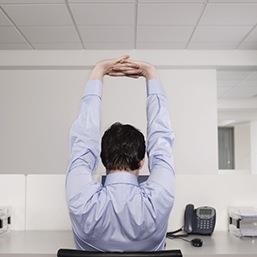- Home
- Mind & body
- Keep calm and stretch
At CBHS we help you manage your health challenges. We believe in offering you the services, support and tools you need to live your best life.
Our Better Living Programs are available to support eligible members towards a healthier lifestyle. Each Better Living Program is subject to its own eligibility criteria.
Contact us for more information and to confirm your eligibility for a program.
Keep calm and stretch

It is estimated that some 80% of people will experience back pain in their lifetime. Back pain is the number one cause of disability and the sixth most common reason for visiting the doctor.
Back pain is not so much a disease but a symptom. For some, back pain is brought on by an injury – a moment where the spine is put under undue pressure or receives a shock. Sudden stresses can result in strains, tears, fractures, disc problems and postural stress, and are often brought on by lifting or pushing a heavy load, sport injuries or a jolt courtesy of a car accident. The lower back is the most common site for these types of injuries.
For others, back pain may be a result of continued strain. Continuous strain includes excess body weight, sitting or standing for long periods, and subjecting the spine to repetitive movements. Those particularly vulnerable to this type of injury are those with poor back condition.
Looking after your spine
When you don’t take care of your back, you’re inviting pain somewhere down the track. A back should be conditioned to handle the stresses of everyday life, as well as some of those harder moments such as lifting a heavy box. Without care, your spine will be more vulnerable to strain and/or pain.
To condition your back it’s important to:
- Exercise regularly to condition the muscles and improve strength and flexibility
- Get enough sleep
- Manage your stress
- Hold a good posture, especially when seated for a long period of time
- Avoid smoking
- Take care when lifting and carrying
Stretching programs in the workplace can work wonders for improving back strength and preventing injury. If your workplace does not have a program in place, talk to your boss or implement some of your own stretches. Lunchtime can be a great time to fit in some exercises and will give you a boost to tackle the afternoon.
Try raising your shoulders towards your ears and holding for 5-10 seconds. Keep the movement slow and repeat five times. You can also slowly roll your shoulders and stretch out the arms. This will help your neck and shoulders.
For your back, stand with your knees slightly bent, place your palms on lower back and gently bend your back backwards. Hold in position for 5-10 seconds and repeat five times.
Stretching specific muscles through physical exercise can elongate muscles to their fullest and help improve the muscles’ elasticity. Stretching can reduce the chance of strain by increasing the flexibility of muscles, tendons and ligaments, which helps in improving range of motion.
On top of this, there is said to be a psychological benefit from starting your day with stretching. When part of a workplace stretching program, there is also the benefit of gathering staff together to take part in an activity that creates bonding experiences and boosts workplace moral.
What to do if you experience back pain
More often than not, back pain will improve by itself in a matter of days or weeks. Getting an appropriate level of rest as well as some gentle walking can help healing time along. Avoid heavy lifting of any kind, bending, twisting or strenuous activity.
If your back pain is causing discomfort, mild painkillers such as paracetamol or aspirin can help relieve the pain. If your discomfort goes on for some time, your GP may refer you to a physiotherapist. You could also try massage, back exercises and spinal manipulation (only by a professional).
In cases of chronic pain, a rehabilitation plan to normalise movement may be required. Those suffering extreme pain that restricts daily activities may also require surgery.
If you do have back pain, what you can do to promote healing is:
• Exercise regularly to condition the muscles and improve strength and flexibility
• Get enough sleep
• Manage your stress
• Avoid smoking
CBHS’s Risk factor Management Program may also be able to assist you with the management of your back pain. If you’re interested in finding out more about this program, please contact our Health and Wellness team on 1300 174 534. Alternatively, you can email wellness@cbhs.com.au.
All information contained in this article is intended for general information purposes only. The information provided should not be relied upon as medical advice and does not supersede or replace a consultation with a suitably qualified healthcare professional.
Health and wellbeing
programs & support
You Belong to More with CBHS Hospital cover:
- Greater choice over your health options including who treats you
- Get care at home with Hospital Substitute Treatment program
- Free health and wellbeing programs to support your health challenges
Live your healthiest, happiest life with CBHS Extras cover:
- Benefits for proactive health checks e.g. bone density tests, eye screenings
- Keep up your care with telehealth and digital options
- Save on dental and optical with CBHS Choice Network providers
